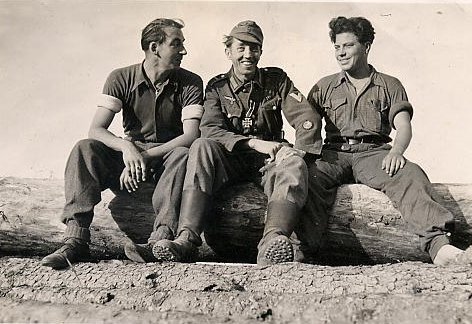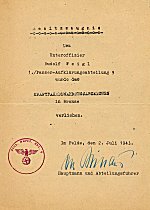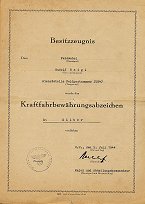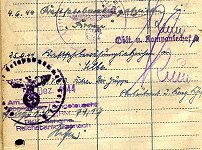
by Stijn David and Sebastián J. Bianchi
This badge has its roots in the drastic developments that motorized warfare underwent in the years prior to World War II, and the fact that highly mobile forces became of vital strategic importance in the success of the Wehrmacht (and all armies involved in the war). The badge was created to recognize both civilian and military drivers who distinguished themselves during combat and who took exceptional care in maintaining their vehicles under the most harsh of conditions. The "Kraftfahrbewährungsabzeichen" was instituted in three grades (Bronze, Silver, Gold) on the 23rd of October 1942 and was made retroactive to 01.12.1940.
Manufacturing and Technical Information
The design of the badge was created by a Waffen-SS enlisted man, and it is rather unusual for a Third Reich decoration in that there is no Swastika to be found on the badge. The design of the badge is simple and consists only of a steering wheel surrounded by laurel leaves. It was presented affixed to a piece of cloth, round or even diamond shaped, in the basic color of the uniform (black, green, blue, etc). The badge is always hollow stamped and is manufactured in either iron or zinc (late war pieces are made from zinc). After it was stamped, the correct finish was applied.

S. Bianchi Collection
Presentation, wear and Documents
The badge was worn in the middle of the lower left arm sleeve of the uniform. Whenever there was a so called drivers distinction (Armeltätigkeitsabzeichen) it had to be worn 2 cm above this distinction.
|
|
|
This picture above of Peter Himbert shows the correct placement of the Driver Proficiency Badge. The photo was taken shortly after he was awarded the Iron Cross 2nd Class. For more pictures and documents of this recipient please visit the Peter Himbert page in the Recipient Gallery |
An award document accompanied the badge and these can vary from from very nice preprinted examples towards machine typed field documents. An award notification was made in the persons papers such as Wehrpass and Soldbuch.
| Field typed award document for the Driver's Badge in
bronze. Click on image to enlarge (Photo Courtesy Angel Farré) |
|
| Official document for the Silver grade.
Click on image to enlarge. (Photo Courtesy Angel Farré)
|
|
|
Soldbuch entries for the Bronze and Silver Driver's Badge.
|
Award criteria
In the case of a military award the badge was rendered by the unit commanding Office, for civilians the badge was authorized by the Minister of the Interior.
The service areas where strictly described for award of this badge and were as follows,
I) Service from 01.12.1940 in the following areas;
- Occupied Yugoslavia, Greece, Bulgaria, Rumania
- Areas to the north of the old Russian border (before the attachment from the Baltic states to the USSR ).
- Finland, Norway (north of the Polar circle or in Lappland )
- Africa
II) Merit in the above mentioned areas under hard conditions, and these are further specified as follow :
- Motorcycle dispatcher : 90 days of service
- Drivers from armed vehicles : 120 days of service
- Drivers from miscellaneous vehicles : 150 days of service (especially close to the fighting forces such as staff drivers)
- Drivers from supply vehicles: 165 days of service
- Drivers attached to different commando units of the Wehrmacht: 185 days of service
The following candidates were eligible for the badge :
- Drivers attached to the Wehrmacht (any branch)
- Drivers (non Wehrmacht personnel) who provided service for the Wehrmacht.
Foreign volunteers could were awarded this badge, but allied troops where excluded. Posthumous awards where not allowed.
With the date of 09.03.1944 the Oberkommando des Heeres added further operational areas to the award criteria as follows,
- From 01.06.1943: Sicily
- From 01.07.1943: Sardinië and Korsika
- From 01.08.1943: The Italian half isle south from the line Ancona - Piombino.
- From 09.09.1943: Albania
Another expansion of the operational areas was made by the Oberkommando des Heeres on 16.05.1944;
- From 01.02.1944 : al the backwards area's from Heeresgruppe Nord im Estonia, Latvia, Lithuania;
The last expansion was made public on 23.09.1944, again by the OdH
- From 01.06.1944 : all the backwards areas on al fronts as been approved by Heeresgruppen Befehl
Exceptions could be made for the required service time providing the nature of the service rendered was exceptional noteworthy or under extremely difficult terrain or climate conditions. Once a person qualified for the badge he was expected to maintain the level of performance, any driving conviction or vehicle neglect would result in the award being withdrawn.
![]()
© Copyright Wehrmacht-Awards.com LLC |



